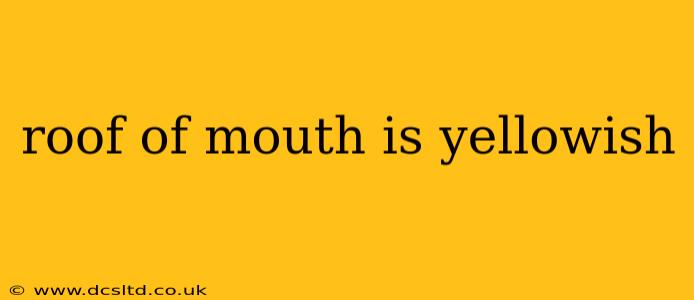A yellowish roof of the mouth, medically known as the palate, can be alarming, but it's often a sign of something minor. However, understanding the potential causes is crucial for addressing the issue effectively. This comprehensive guide explores various reasons for a yellow palate, helping you determine when a doctor's visit is necessary.
What Causes a Yellow Roof of the Mouth?
Several factors can contribute to a yellow discoloration of the palate. These range from harmless temporary conditions to more serious underlying health issues. Let's examine some of the most common causes:
Dehydration:
Dehydration can cause a yellowish tinge to the roof of your mouth. Lack of sufficient fluid intake leads to a dry mouth, and the accumulated dead cells can appear yellowish. Increased fluid intake usually resolves this issue quickly.
Smoking and Tobacco Use:
Smoking and the use of other tobacco products are significant contributors to yellowing of the palate. The nicotine and tar in tobacco stain the soft tissues of the mouth, leading to a yellowish or brownish discoloration. Quitting tobacco use is crucial for improving oral health and reversing this discoloration.
Food and Drink:
Certain foods and drinks, particularly those with strong pigments, can temporarily stain the roof of the mouth. Curry, turmeric, and other intensely colored spices are common culprits. Good oral hygiene, including thorough brushing and flossing, can help remove these stains.
Poor Oral Hygiene:
Neglecting oral hygiene practices can lead to a buildup of plaque and bacteria, resulting in a yellow or yellowish-brown discoloration of the palate. Regular brushing, flossing, and rinsing with mouthwash are essential for maintaining oral health.
Medications:
Some medications can cause a yellowing of the mouth as a side effect. This is usually temporary and resolves once the medication is discontinued. Always consult your doctor or pharmacist if you suspect medication is the cause.
Jaundice:
In more serious cases, a yellow palate can be a symptom of jaundice, which indicates a problem with the liver. Jaundice causes a yellowing of the skin, eyes, and mucous membranes, including the roof of the mouth. This condition requires immediate medical attention.
Oral Thrush (Candidiasis):
Oral thrush is a fungal infection that can cause white or yellowish patches on the tongue, roof of the mouth, and other areas of the mouth. It's often associated with weakened immune systems or antibiotic use. Treatment typically involves antifungal medication.
Is a Yellow Roof of the Mouth Serious?
The seriousness of a yellow roof of the mouth depends on the underlying cause. While many causes are benign and easily treatable, some require immediate medical attention. If the yellowing is accompanied by other symptoms, such as fever, fatigue, or changes in bowel movements, it's crucial to seek medical advice.
When Should I See a Doctor About a Yellow Roof of the Mouth?
You should consult a doctor if:
- The yellowing is persistent and doesn't improve with good oral hygiene.
- The yellowing is accompanied by other symptoms, such as pain, fever, or fatigue.
- You notice changes in your skin or eyes, such as yellowing.
- You have a weakened immune system.
- You're experiencing unusual changes in your bowel movements.
How Can I Prevent a Yellow Roof of the Mouth?
Maintaining good oral hygiene is crucial for preventing a yellow roof of the mouth. This includes:
- Brushing your teeth twice a day.
- Flossing daily.
- Using mouthwash regularly.
- Staying well-hydrated.
- Quitting smoking and tobacco use.
- Eating a balanced diet.
This information is for general knowledge and doesn't constitute medical advice. Always consult a healthcare professional for any health concerns.
